Abstract
Androgens regulate breast cancer cell proliferation via androgen receptor (AR)-mediated mechanisms. To investigate further the androgen-responsiveness of human breast tumours, we examined the immunohistochemical expression of the AR and two androgen-regulated proteins, prostate-specific antigen (PSA) and gross cystic disease fluid protein-15 (GCDFP-15), in 72 primary breast tumours. AR immunoreactivity was present in the nuclei of breast tumour cells and was correlated with oestrogen receptor (ER; P < 0.05) and progesterone receptor (PR; P < 0.01) status. PSA and GCDFP-15 immunoreactivity was present in the cytoplasm of tumour cells but not the adjacent stromal cells. AR-positive cells were present in 85% (61/72) of breast tumours, and 98% (43/44) of PSA-positive and 92% (44/48) of GCDFP-15-positive tumours were also positive for AR. Positive immunoreactivity for both PSA and GCDFP-15 in breast tumours was highly dependent on AR status (odds ratios of 24.0 and 4.5 respectively), but unrelated to age, ER and PR status and axillary lymph node involvement. PSA immunoreactivity was more frequently observed in moderate and well-differentiated tumours and was significantly (P < 0.001) associated with GCDFP-15 immunoreactivity. In conclusion, PSA and GCDFP-15 immunoreactivity was dependent on the presence of AR, but not ER or PR in primary breast tumours.
Full text
PDF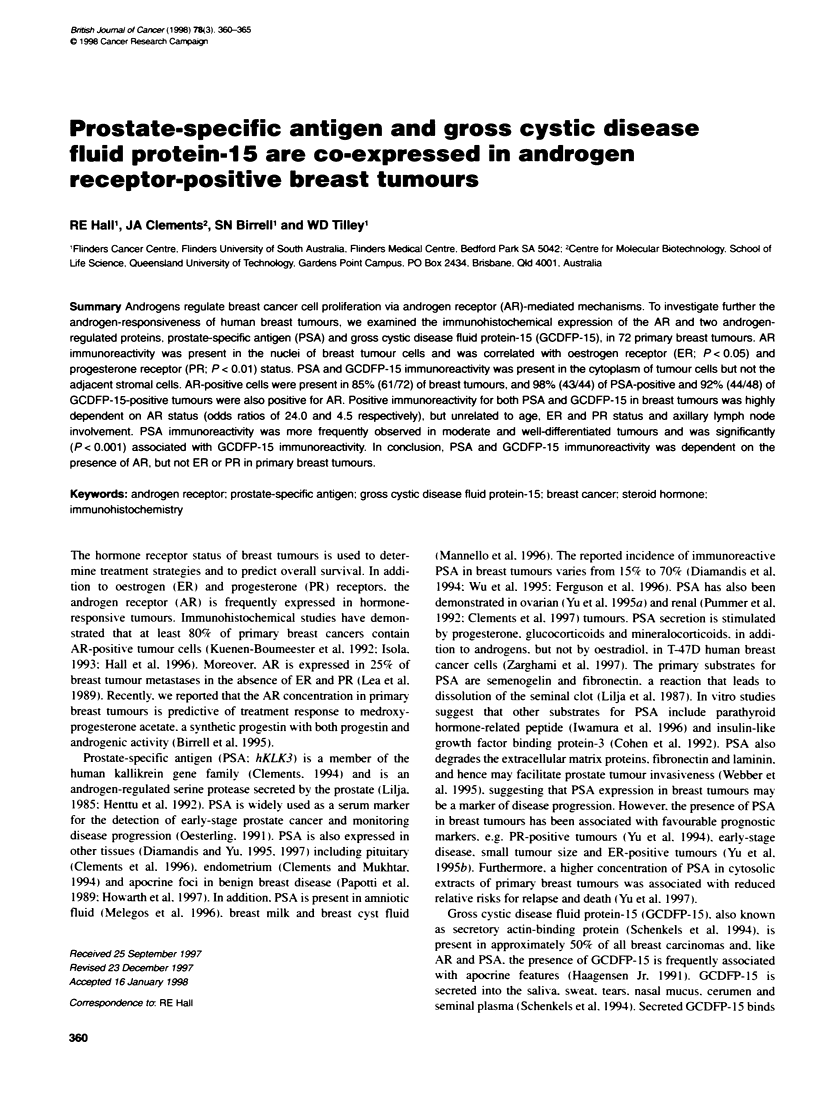
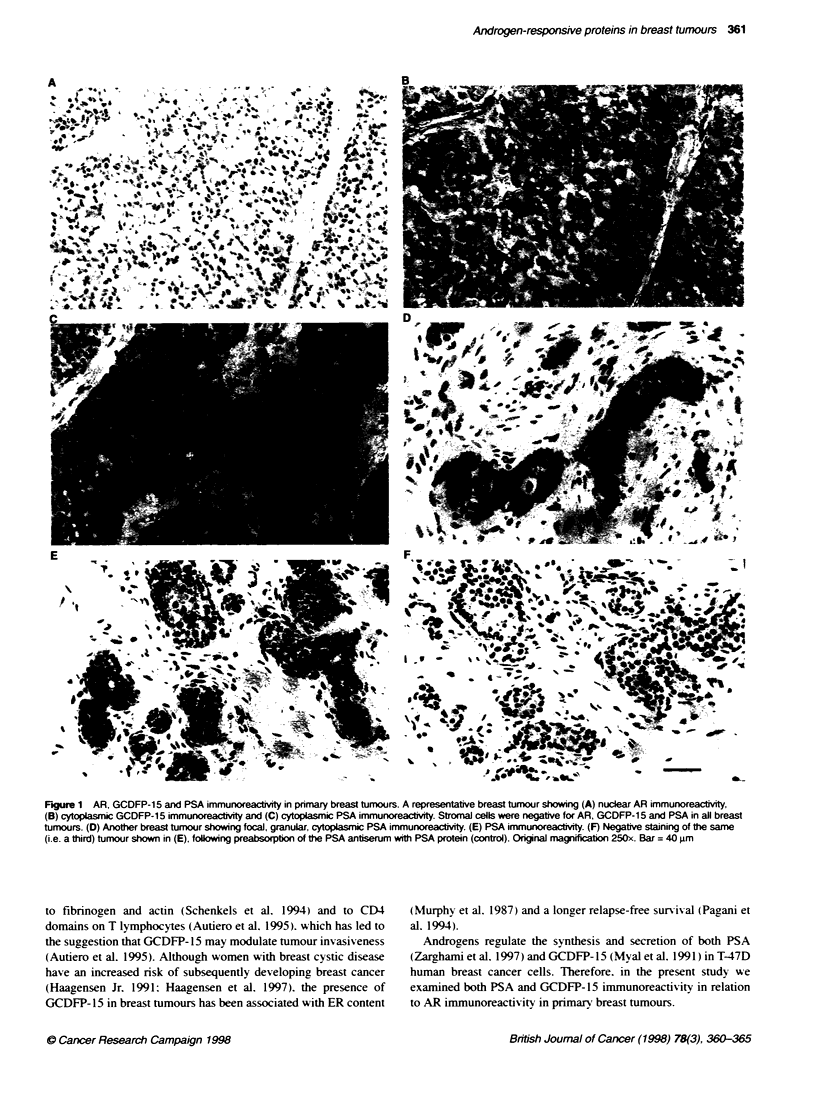
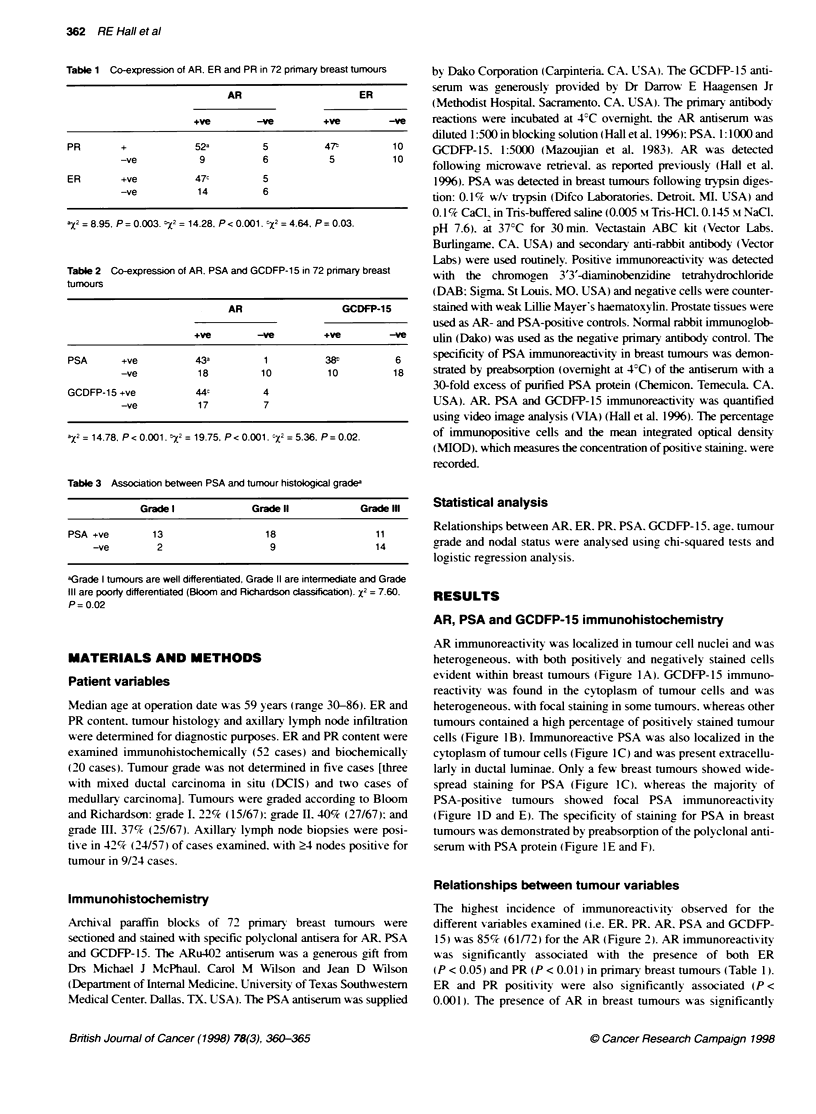
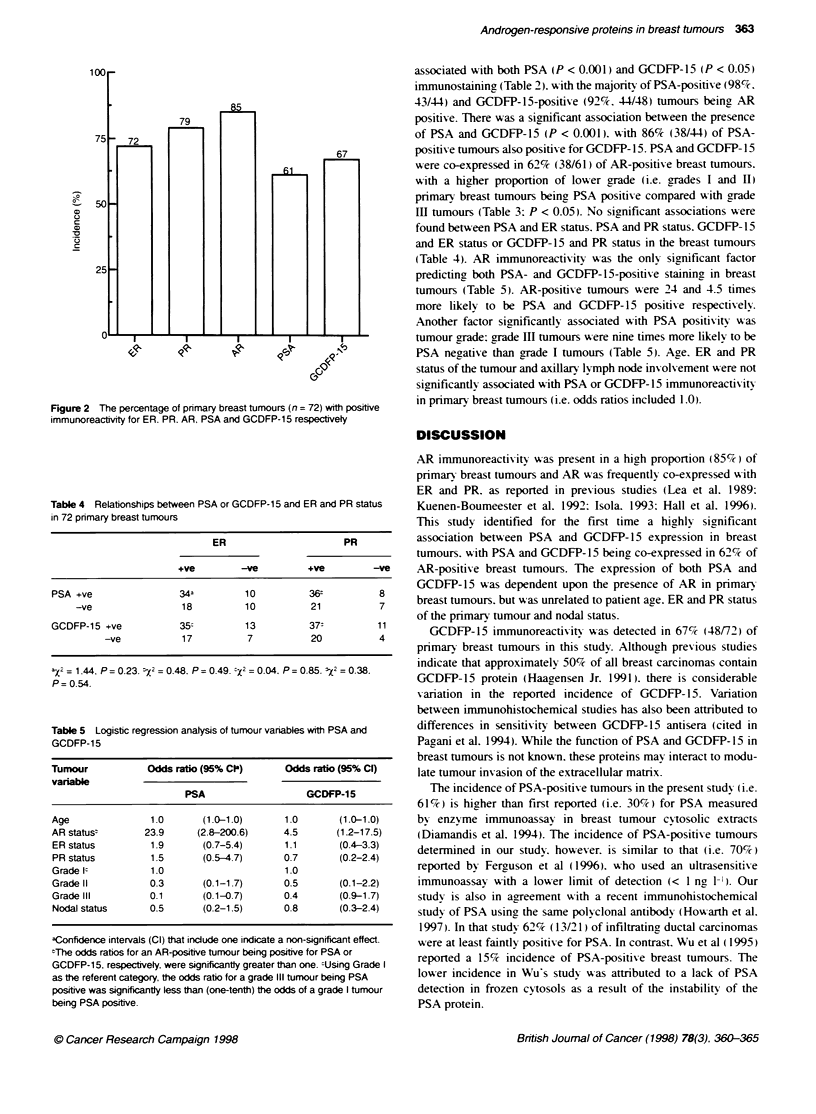

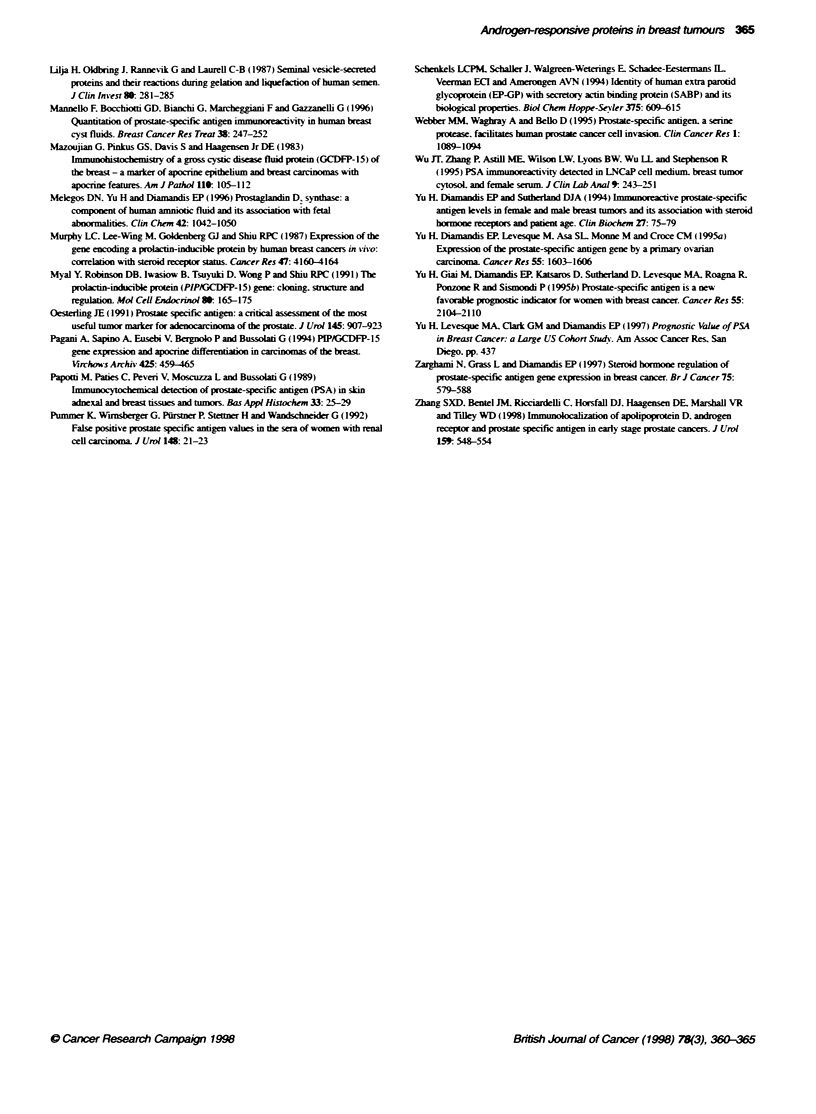
Images in this article
Selected References
These references are in PubMed. This may not be the complete list of references from this article.
- Abrahamsson P. A., Lilja H., Falkmer S., Wadström L. B. Immunohistochemical distribution of the three predominant secretory proteins in the parenchyma of hyperplastic and neoplastic prostate glands. Prostate. 1988;12(1):39–46. doi: 10.1002/pros.2990120106. [DOI] [PubMed] [Google Scholar]
- Aspinall J. O., Bentel J. M., Horsfall D. J., Haagensen D. E., Marshall V. R., Tilley W. D. Differential expression of apolipoprotein-D and prostate specific antigen in benign and malignant prostate tissues. J Urol. 1995 Aug;154(2 Pt 1):622–628. doi: 10.1097/00005392-199508000-00082. [DOI] [PubMed] [Google Scholar]
- Autiero M., Cammarota G., Friedlein A., Zulauf M., Chiappetta G., Dragone V., Guardiola J. A 17-kDa CD4-binding glycoprotein present in human seminal plasma and in breast tumor cells. Eur J Immunol. 1995 May;25(5):1461–1464. doi: 10.1002/eji.1830250550. [DOI] [PubMed] [Google Scholar]
- Birrell S. N., Roder D. M., Horsfall D. J., Bentel J. M., Tilley W. D. Medroxyprogesterone acetate therapy in advanced breast cancer: the predictive value of androgen receptor expression. J Clin Oncol. 1995 Jul;13(7):1572–1577. doi: 10.1200/JCO.1995.13.7.1572. [DOI] [PubMed] [Google Scholar]
- Clements J. A., Mukhtar A., Verity K., Pullar M., McNeill P., Cummins J., Fuller P. J. Kallikrein gene expression in human pituitary tissues. Clin Endocrinol (Oxf) 1996 Feb;44(2):223–231. doi: 10.1046/j.1365-2265.1996.661481.x. [DOI] [PubMed] [Google Scholar]
- Clements J., Mukhtar A. Glandular kallikreins and prostate-specific antigen are expressed in the human endometrium. J Clin Endocrinol Metab. 1994 Jun;78(6):1536–1539. doi: 10.1210/jcem.78.6.7515392. [DOI] [PubMed] [Google Scholar]
- Clements J., Ward G., Kaushal A., Hi S. I., Kennett C., Nicol D. A prostate-specific antigen-like protein associated with renal cell carcinoma in women. Clin Cancer Res. 1997 Aug;3(8):1427–1431. [PubMed] [Google Scholar]
- Cohen P., Graves H. C., Peehl D. M., Kamarei M., Giudice L. C., Rosenfeld R. G. Prostate-specific antigen (PSA) is an insulin-like growth factor binding protein-3 protease found in seminal plasma. J Clin Endocrinol Metab. 1992 Oct;75(4):1046–1053. doi: 10.1210/jcem.75.4.1383255. [DOI] [PubMed] [Google Scholar]
- Diamandis E. P., Yu H. Nonprostatic sources of prostate-specific antigen. Urol Clin North Am. 1997 May;24(2):275–282. doi: 10.1016/s0094-0143(05)70373-6. [DOI] [PubMed] [Google Scholar]
- Diamandis E. P., Yu H., Sutherland D. J. Detection of prostate-specific antigen immunoreactivity in breast tumors. Breast Cancer Res Treat. 1994;32(3):301–310. doi: 10.1007/BF00666007. [DOI] [PubMed] [Google Scholar]
- Ferguson R. A., Yu H., Kalyvas M., Zammit S., Diamandis E. P. Ultrasensitive detection of prostate-specific antigen by a time-resolved immunofluorometric assay and the Immulite immunochemiluminescent third-generation assay: potential applications in prostate and breast cancers. Clin Chem. 1996 May;42(5):675–684. [PubMed] [Google Scholar]
- Haagensen D. E., Jr Is cystic disease related to breast cancer? Am J Surg Pathol. 1991 Jul;15(7):687–694. doi: 10.1097/00000478-199107000-00010. [DOI] [PubMed] [Google Scholar]
- Hall R. E., Aspinall J. O., Horsfall D. J., Birrell S. N., Bentel J. M., Sutherland R. L., Tilley W. D. Expression of the androgen receptor and an androgen-responsive protein, apolipoprotein D, in human breast cancer. Br J Cancer. 1996 Oct;74(8):1175–1180. doi: 10.1038/bjc.1996.513. [DOI] [PMC free article] [PubMed] [Google Scholar]
- Henttu P., Liao S. S., Vihko P. Androgens up-regulate the human prostate-specific antigen messenger ribonucleic acid (mRNA), but down-regulate the prostatic acid phosphatase mRNA in the LNCaP cell line. Endocrinology. 1992 Feb;130(2):766–772. doi: 10.1210/endo.130.2.1370795. [DOI] [PubMed] [Google Scholar]
- Howarth D. J., Aronson I. B., Diamandis E. P. Immunohistochemical localization of prostate-specific antigen in benign and malignant breast tissues. Br J Cancer. 1997;75(11):1646–1651. doi: 10.1038/bjc.1997.280. [DOI] [PMC free article] [PubMed] [Google Scholar]
- Isola J. J. Immunohistochemical demonstration of androgen receptor in breast cancer and its relationship to other prognostic factors. J Pathol. 1993 May;170(1):31–35. doi: 10.1002/path.1711700106. [DOI] [PubMed] [Google Scholar]
- Iwamura M., Hellman J., Cockett A. T., Lilja H., Gershagen S. Alteration of the hormonal bioactivity of parathyroid hormone-related protein (PTHrP) as a result of limited proteolysis by prostate-specific antigen. Urology. 1996 Aug;48(2):317–325. doi: 10.1016/S0090-4295(96)00182-3. [DOI] [PubMed] [Google Scholar]
- Kuenen-Boumeester V., Van der Kwast T. H., van Putten W. L., Claassen C., van Ooijen B., Henzen-Logmans S. C. Immunohistochemical determination of androgen receptors in relation to oestrogen and progesterone receptors in female breast cancer. Int J Cancer. 1992 Oct 21;52(4):581–584. doi: 10.1002/ijc.2910520415. [DOI] [PubMed] [Google Scholar]
- Lea O. A., Kvinnsland S., Thorsen T. Improved measurement of androgen receptors in human breast cancer. Cancer Res. 1989 Dec 15;49(24 Pt 1):7162–7167. [PubMed] [Google Scholar]
- Lilja H. A kallikrein-like serine protease in prostatic fluid cleaves the predominant seminal vesicle protein. J Clin Invest. 1985 Nov;76(5):1899–1903. doi: 10.1172/JCI112185. [DOI] [PMC free article] [PubMed] [Google Scholar]
- Lilja H., Oldbring J., Rannevik G., Laurell C. B. Seminal vesicle-secreted proteins and their reactions during gelation and liquefaction of human semen. J Clin Invest. 1987 Aug;80(2):281–285. doi: 10.1172/JCI113070. [DOI] [PMC free article] [PubMed] [Google Scholar]
- Mannello F., Bocchiotti G., Bianchi G., Marcheggiani F., Gazzanelli G. Quantification of prostate-specific antigen immunoreactivity in human breast cyst fluids. Breast Cancer Res Treat. 1996;38(3):247–252. doi: 10.1007/BF01806142. [DOI] [PubMed] [Google Scholar]
- Mazoujian G., Pinkus G. S., Davis S., Haagensen D. E., Jr Immunohistochemistry of a gross cystic disease fluid protein (GCDFP-15) of the breast. A marker of apocrine epithelium and breast carcinomas with apocrine features. Am J Pathol. 1983 Feb;110(2):105–112. [PMC free article] [PubMed] [Google Scholar]
- Melegos D. N., Yu H., Diamandis E. P. Prostaglandin D2 synthase: a component of human amniotic fluid and its association with fetal abnormalities. Clin Chem. 1996 Jul;42(7):1042–1050. [PubMed] [Google Scholar]
- Murphy L. C., Lee-Wing M., Goldenberg G. J., Shiu R. P. Expression of the gene encoding a prolactin-inducible protein by human breast cancers in vivo: correlation with steroid receptor status. Cancer Res. 1987 Aug 1;47(15):4160–4164. [PubMed] [Google Scholar]
- Myal Y., Robinson D. B., Iwasiow B., Tsuyuki D., Wong P., Shiu R. P. The prolactin-inducible protein (PIP/GCDFP-15) gene: cloning, structure and regulation. Mol Cell Endocrinol. 1991 Sep;80(1-3):165–175. doi: 10.1016/0303-7207(91)90153-j. [DOI] [PubMed] [Google Scholar]
- Oesterling J. E. Prostate specific antigen: a critical assessment of the most useful tumor marker for adenocarcinoma of the prostate. J Urol. 1991 May;145(5):907–923. doi: 10.1016/s0022-5347(17)38491-4. [DOI] [PubMed] [Google Scholar]
- Pagani A., Sapino A., Eusebi V., Bergnolo P., Bussolati G. PIP/GCDFP-15 gene expression and apocrine differentiation in carcinomas of the breast. Virchows Arch. 1994;425(5):459–465. doi: 10.1007/BF00197548. [DOI] [PubMed] [Google Scholar]
- Papotti M., Paties C., Peveri V., Moscuzza L., Bussolati G. Immunocytochemical detection of prostate-specific antigen (PSA) in skin adnexal and breast tissues and tumors. Basic Appl Histochem. 1989;33(1):25–29. [PubMed] [Google Scholar]
- Pummer K., Wirnsberger G., Pürstner P., Stettner H., Wandschneider G. False positive prostate specific antigen values in the sera of women with renal cell carcinoma. J Urol. 1992 Jul;148(1):21–23. doi: 10.1016/s0022-5347(17)36497-2. [DOI] [PubMed] [Google Scholar]
- Schenkels L. C., Schaller J., Walgreen-Weterings E., Schadee-Eestermans I. L., Veerman E. C., Nieuw Amerongen A. V. Identity of human extra parotid glycoprotein (EP-GP) with secretory actin binding protein (SABP) and its biological properties. Biol Chem Hoppe Seyler. 1994 Sep;375(9):609–615. doi: 10.1515/bchm3.1994.375.9.609. [DOI] [PubMed] [Google Scholar]
- Webber M. M., Waghray A., Bello D. Prostate-specific antigen, a serine protease, facilitates human prostate cancer cell invasion. Clin Cancer Res. 1995 Oct;1(10):1089–1094. [PubMed] [Google Scholar]
- Wu J. T., Zhang P., Astill M. E., Wilson L. W., Lyons B. W., Wu L. L., Stephenson R. PSA immunoreactivity detected in LNCaP cell medium, breast tumor cytosol, and female serum. J Clin Lab Anal. 1995;9(4):243–251. doi: 10.1002/jcla.1860090406. [DOI] [PubMed] [Google Scholar]
- Yu H., Diamandis E. P., Levesque M., Asa S. L., Monne M., Croce C. M. Expression of the prostate-specific antigen gene by a primary ovarian carcinoma. Cancer Res. 1995 Apr 15;55(8):1603–1606. [PubMed] [Google Scholar]
- Yu H., Diamandis E. P., Sutherland D. J. Immunoreactive prostate-specific antigen levels in female and male breast tumors and its association with steroid hormone receptors and patient age. Clin Biochem. 1994 Apr;27(2):75–79. doi: 10.1016/0009-9120(94)90015-9. [DOI] [PubMed] [Google Scholar]
- Yu H., Giai M., Diamandis E. P., Katsaros D., Sutherland D. J., Levesque M. A., Roagna R., Ponzone R., Sismondi P. Prostate-specific antigen is a new favorable prognostic indicator for women with breast cancer. Cancer Res. 1995 May 15;55(10):2104–2110. [PubMed] [Google Scholar]
- Zarghami N., Grass L., Diamandis E. P. Steroid hormone regulation of prostate-specific antigen gene expression in breast cancer. Br J Cancer. 1997;75(4):579–588. doi: 10.1038/bjc.1997.101. [DOI] [PMC free article] [PubMed] [Google Scholar]
- Zhang S. X., Bentel J. M., Ricciardelli C., Horsfall D. J., Haagensen D. E., Marshall V. R., Tilley W. D. Immunolocalization of apolipoprotein D, androgen receptor and prostate specific antigen in early stage prostate cancers. J Urol. 1998 Feb;159(2):548–554. doi: 10.1016/s0022-5347(01)63981-8. [DOI] [PubMed] [Google Scholar]



